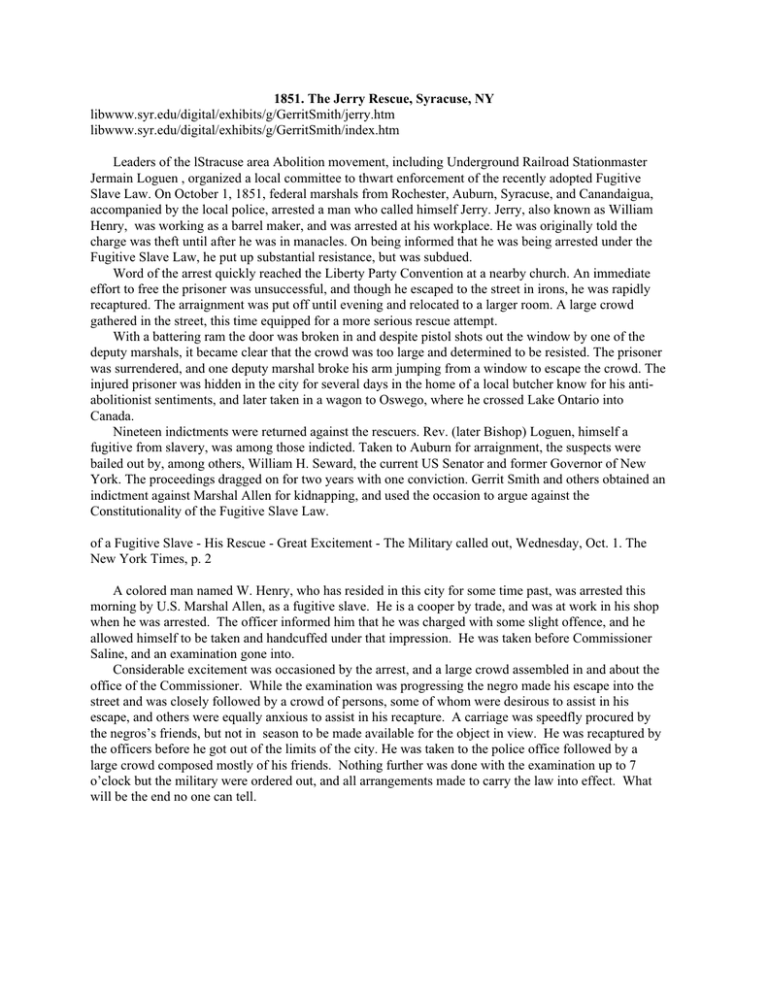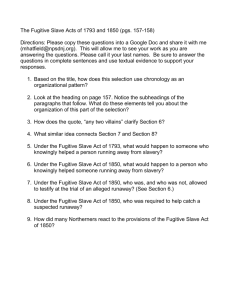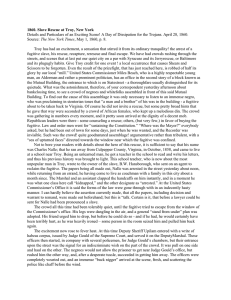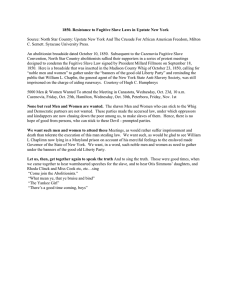1851. The Jerry Rescue, Syracuse, NY libwww.syr.edu/digital/exhibits/g/GerritSmith/jerry.htm libwww.syr.edu/digital/exhibits/g/GerritSmith/index.htm
advertisement

1851. The Jerry Rescue, Syracuse, NY libwww.syr.edu/digital/exhibits/g/GerritSmith/jerry.htm libwww.syr.edu/digital/exhibits/g/GerritSmith/index.htm Leaders of the lStracuse area Abolition movement, including Underground Railroad Stationmaster Jermain Loguen , organized a local committee to thwart enforcement of the recently adopted Fugitive Slave Law. On October 1, 1851, federal marshals from Rochester, Auburn, Syracuse, and Canandaigua, accompanied by the local police, arrested a man who called himself Jerry. Jerry, also known as William Henry, was working as a barrel maker, and was arrested at his workplace. He was originally told the charge was theft until after he was in manacles. On being informed that he was being arrested under the Fugitive Slave Law, he put up substantial resistance, but was subdued. Word of the arrest quickly reached the Liberty Party Convention at a nearby church. An immediate effort to free the prisoner was unsuccessful, and though he escaped to the street in irons, he was rapidly recaptured. The arraignment was put off until evening and relocated to a larger room. A large crowd gathered in the street, this time equipped for a more serious rescue attempt. With a battering ram the door was broken in and despite pistol shots out the window by one of the deputy marshals, it became clear that the crowd was too large and determined to be resisted. The prisoner was surrendered, and one deputy marshal broke his arm jumping from a window to escape the crowd. The injured prisoner was hidden in the city for several days in the home of a local butcher know for his antiabolitionist sentiments, and later taken in a wagon to Oswego, where he crossed Lake Ontario into Canada. Nineteen indictments were returned against the rescuers. Rev. (later Bishop) Loguen, himself a fugitive from slavery, was among those indicted. Taken to Auburn for arraignment, the suspects were bailed out by, among others, William H. Seward, the current US Senator and former Governor of New York. The proceedings dragged on for two years with one conviction. Gerrit Smith and others obtained an indictment against Marshal Allen for kidnapping, and used the occasion to argue against the Constitutionality of the Fugitive Slave Law. of a Fugitive Slave - His Rescue - Great Excitement - The Military called out, Wednesday, Oct. 1. The New York Times, p. 2 A colored man named W. Henry, who has resided in this city for some time past, was arrested this morning by U.S. Marshal Allen, as a fugitive slave. He is a cooper by trade, and was at work in his shop when he was arrested. The officer informed him that he was charged with some slight offence, and he allowed himself to be taken and handcuffed under that impression. He was taken before Commissioner Saline, and an examination gone into. Considerable excitement was occasioned by the arrest, and a large crowd assembled in and about the office of the Commissioner. While the examination was progressing the negro made his escape into the street and was closely followed by a crowd of persons, some of whom were desirous to assist in his escape, and others were equally anxious to assist in his recapture. A carriage was speedfly procured by the negros’s friends, but not in season to be made available for the object in view. He was recaptured by the officers before he got out of the limits of the city. He was taken to the police office followed by a large crowd composed mostly of his friends. Nothing further was done with the examination up to 7 o’clock but the military were ordered out, and all arrangements made to carry the law into effect. What will be the end no one can tell.







